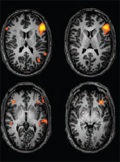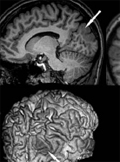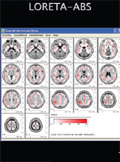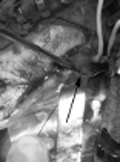The eLitMed.hu medical portal uses computer cookies for convenient operation. Detailed information can be found in the Cookie-policy.
Clinical Neuroscience - 2011;64(09-10)
Content
[Functional magnetic resonance imaging for cortical mapping in epilepsy]
[It is not only the total curative resection of pathological tissue or the minimization of symptoms to be considered in epilepsy surgery or other neurosurgical procedures, it is equally desirable to maintain the best possible quality of life. Cortical mapping methods can help achieve this goal by delineating eloquent areas, i.e. brain regions that are vital for providing an acceptable quality of life, albeit not prone to compensatory reorganization. These areas include among others the Broca and Wernicke regions for speech, the primary motor, sensory and visual cortices. Functional MRI gained importance in the last decade as a non-invasive clinical cortical mapping technique. This method is capable of localizing cortical areas selectively activated by a given task condition. Thus, selecting appropriate tasks can help mapping eloquent brain regions. Using functional MRI provides information that is complementary to other mapping methods. Moreover, it can replace invasive methods such as the Wada test. Here, we explain the background of functional MRI, compare it to other clinical mapping methods, explain the intricacies of paradigm selection, and show the limitations of the technique while also pointing out alternative uses.]
[Magnetic resonance measuring and analitic methods in epilepsy]
[Neuroradiology and magnetic resonance imaging (MRI) as its leading tool play a basic role in the diagnostics of epilepsy. The result of the MRI examination is of utmost importance in patients with therapy resistent focal epilepsy possibly requiring neurosurgical intervention. Based on the continuously developing MRI techniques, we can use an optimal imaging protocol. Cerebral structures can be evaluated on a microanatomical level on high-resolution images with thin slices. The three-dimensional (3D) sequence has high spatial resolution, properly distinguishes cerebral grey and white matter, provides the possibility of surface rendering and volumetry, as well as an anatomical basis for other methods like tractography, functional MRI and neuronavigation. Diffusion weighted and diffusion tensor imaging (DWI, DTI) and tractography has an important role in differential diagnostics and tractography visualizes the main white matter tracts and their relation with brain pathologies. MR perfusion (MRP) provides help in differential diagnostics and may have a future role in the determination of the epileptogenic focus in multifocal pathologies. MR spectroscopy (MRS) is important in differential diagnostics, lateralization of focal epilepsy and in the confirmation of hippocampal sclerosis. Several of these methods need special hardware, software and expertise, but the basic MRI protocol for epilepsy can be implemented in all modern MR scanners of middle or high field strength.]
[LORETA (Low Resolution Electromagnetic Tomography): A three-dimensional EEG source localization method]
[The author presents a brief overview of the EEG source localization method LORETA (Low Resolution Electromagnetic Tomography) with special reference to the not widely discussed data.]
[The methodology and objectives of registrating high frequency oscillation in epilepsy]
[Technological advances in digital EEG allowed the recording the full frequency band of the EEG. Activity beyond the traditional 0.3-70 Hz band reflects both physiological and pathological processes. High frequency activity recorded from the epileptic brain has been related to both epileptogenicity and epileptogenesis. The article reviews research avenues, clinical applications, and the methodology of detecting and quantifying high frequency activity.]
[Prolonged EEG-monitoring]
[Prolonged EEG monitoring and video-EEG monitoring are basic methods on the level of epilepsy centers. These methods are able to make differences between epilepsy and non epileptic paroxysmal manifestations like psychogenic non epileptic seizures, parasomniac phenomena, narcolepsy. The application of the method, at least the video-EEG variant, needs team work, high level organisation, highly educated staff and high tech electrographic devices. Running the method even with these requirements is beneficial from the cost-benefit aspect as well.]
[Role of deep brain stimulation in epilepsy]
[The deep brain stimulation (DBS) is an emerging treatment option in brain disorders in which randomized multicenter trials proved its efficacy leading to licensing different DBS methods in various brain diseases. More recently more and more brain structures have become candidates for being “target” in a possible DBS treatment of epilepsy. At present, only the DBS of the anterior nucleus of the thalamus (ANT) can be considered as a proved method for epilepsy treatment. Other potential targets for DBS treatment in epilepsy are the subthalamic nuclei, and the amygdala- hippocampus complex. There are some ongoing randomized studies to investigating their therapeutical role. The therapeutical outcome of ANT-DBS treatment in drug-resistant epilepsy seems to be better than the new antiepileptic drugs, but much worse than the results of a potential epilepsy surgery. At about 10% of patients may become seizure-free and 50% of patients may have a significant improvement. Nowadays ANT-DBS should be considered as an “ultima ratio” in those adult drug-resistant epilepsy patients with normal intelligence in which neither new antiepileptic drugs nor resective epilepsy surgery are a reasonable therapeutical options.]
[The clinical utility of genetic testing in epilepsy]
[We summarize those epilepsies, in which genetic testing has clinical significance. Different types of genetic tests are presented. Na-channel epilepsies include different clinical entities, the exact genetic diagnosis is relevant in the prognosis, genetic counseling, as well in the therapeutic decision - as Na-channel blockers may worsen them. Molecular genetic tests are available for most of the malformations of cortical development, important for genetic counseling and prenatal diagnosis. Molecular genetic testing of progressive myoclonic epilepsies, which may be difficult to differentiate clinically is almost complete. For some neonatal/infantile epileptic encephalopathies, for most of the neurometabolic disorders, molecular genetic tests are available, so are cytogenetic tests for chromosomal abnormalities accompanied with epilepsy. The clinical significance of the genetic diagnostic of rare, focal inherited epilepsies is limited, their importance is mostly in epilepsy pathophysiology research. The genetic background of the common idiopathic generalized epilepsies is unrevealed so far.]
[Critical analysis of types and objectives of phamacological trials]
[Antiepileptic drug randomized controlled trial (RCT) design has been criticized in the near past. Designs emphasize conventions and regulations more than clinical aspects. In the new study that scrutinized RCT patient recruitment has also raised important ethical issues. The time has come when changes in RCT design seem imperative.]
[New antiepileptic drugs, and therapeutic considerations]
[Epilepsy is not a singular disease, but a variety of disorders. It is affects up to 0.5% of the population. Over the past decade, the researchers have been made great advances in the field of epilepsy. These have been accompanied by the licensing of a great number of antiepileptic drugs. However, despite these efforts, up to 15-20% of patients have refractory epilepsy. The novel antiepileptic drugs must suit several requirements: higher efficacy, especially in resistant cases, better tolerability, and improved pharmacokinetic properties. Recently, three new drugs have been introduced for the medication. The retigabine is a carbamic derivate, and the anticonvulsive properties are largely due to its ability to prolong the opening of neuronal voltage-gated potassium Kv7.2 and Kv7.3 channels. The lacosamide is a functionalized amino acid, and selectively enhances voltage-gated sodium channel slow inactivation. The eslicarbazepine acetate is a new member of the dibenzazepine family, and blocks the fast inactivated voltage-gated sodium channel. All three of them differ from the foregoing agents in several important ways, including new mechanism of action (retigabine, lacosamide), or pharmacokinetics (eslicarbazepine acetate). These novel anticonvulsants appears to be a safe and effective addition to the armamentarium for the treatment of patients with refractory epilepsy. However, it must take some new approaches into consideration, in the therapeutic algorithm.]
[The role of neuronavigation in the preoperative invasive evaluation and surgical treatment of drug resistant epilepsies]
[For localizing the epileptogenic zone in cases of focal epilepsies detailed clinical investigations, imaging studies and electrophysiological methods are in use. In lesional epilepsies the intrapreoperatíve localization of the lesion and it’s location to the eloquent cortex is essential for the neurosurgeon. The development in image guided neurosurgery lead us to use neuronavigation systems to localize intracerebral lesions or functionally eloquent cortical areas or subcortical pathways during surgery. Neuronavigation brought changes in preoperatíve evaluation and in resective surgery in epilepsy as well. In this article we describe the basics of neuronavigation and enhance the advantages of the technique in epilepsy surgery during the presurgical evaluation with invasive electrodes, in resective surgery and DBS for epilepsy.]
[Neuropsychological methods and trends in epilepsy management]
[Neuropsychological assessment makes its own valuable contribution to diagnosis in epilepsy, and the integration of those findings with the data from multiple sources provides the most comprehensive picture for a given epilepsy patient. The objective of this paper is to define and summarize the role and methods of neuropsychological assessment, and to present recommendations on themes for future clinical research in the neuropsychology of epilepsy.]
[Oligoepilepsy: a real entity or the benign form of epileptic disorder?]
[Background and purpose - Although oligoepilepsy (OLE) is a used term in many protocols, guidelines and the everyday routine, it is found practically nowhere in the scientific literature. The aim of our study is to investigate and evaluate of the main characteristics of his subcategory of epilepsy. We try to find answer to the basic question of not only theoretical but also great practical importance whether the OLE does really exist, is it an independent entity of epilepsy or only its general benign clinical presentation. Methods - We considered OLE if the patients had two seizures maximally in the last year of their course. We counted only the two most severe clinical types, the generalized tonic-clonic and the complex partial seizures. We divided the OLE into two subtypes: those patients who had OLE from the beginning of their epilepsy (OLE1) and those ones, in whom the OLE was the result of the treatment (OLE2). We analysed retrospectively the data of 817 “OLE-suspicious” patients taken from our EPIMED database Results - We found 47 patients met the inclusion criteria (OLE1=34, OLE2=13). OLE patients did not differ from the general epileptic population according to the age and gender, the type of seizures, the electro-clinical diagnosis and the possible cause of their first seizure. But we found statistically significant differences in two measures. In OLE, far less seizure provoking factors were found in the sporadic seizures. Concerning the social conditions: while the range of employees was equal, the vast majority of OLE patients were able to work at their level of education. Conclusion - We found that more than 5% of people with epilepsy can belong to the OLE category. In the majority of OLE patients the seizure frequency is low from the beginning of the disease. The sporadic seizures in OLE are generally not provoked. The chances of OLE patients in the world of job are better for the OLE patients. In our opinion OLE rather seems to be an independent entity among epilepsy. Therefore larger prospective studies are needed to the exact description of OLE and to establish the special standards for the everyday medical practice.]
1.
Clinical Neuroscience
[Headache registry in Szeged: Experiences regarding to migraine patients]2.
Clinical Neuroscience
[The new target population of stroke awareness campaign: Kindergarten students ]3.
Clinical Neuroscience
Is there any difference in mortality rates of atrial fibrillation detected before or after ischemic stroke?4.
Clinical Neuroscience
Factors influencing the level of stigma in Parkinson’s disease in western Turkey5.
Clinical Neuroscience
[The effects of demographic and clinical factors on the severity of poststroke aphasia]1.
2.
Clinical Oncology
[Pancreatic cancer: ESMO Clinical Practice Guideline for diagnosis, treatment and follow-up]3.
Clinical Oncology
[Pharmacovigilance landscape – Lessons from the past and opportunities for future]4.
5.
















